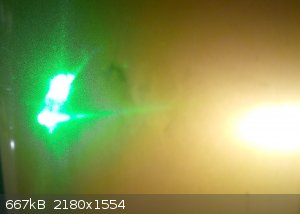
khlor - 25-11-2020 at 18:21
I was trying to use electrolysis to remove copper from some graphite electrodes and I put these electrodes as anodes in a sodium chloride solution and
as cathode I used a stabdard graphite rod(no cooper here) and connected to a 20v 3.6A power supply, the current drawn was about 2A, at the beginning
it as all as I expected, the blue oxide started to preciptate, but then a black stuff started forming, and it turned all black(like the paint it black
from the Rolling Stones) and brownish black stuff and it got hot, but at the bottom cold as usual... I turned it off, and I was left with a fine dark
suspension that slowly (took days) to precipitate and eveb then, when I shine a laser beam it shows floating particles, I got a couple of photos,
sorry, not so good quality though, but it will help you get the Idea of what I'm talking about.
I'm not sure of what it is nor what to do with it, I googled applications of copper nanoparticles and it seems that there isn't much I could do with
it.


Bedlasky - 25-11-2020 at 18:45
It is mix of graphite and CuO. Cu(OH)2 decompose at 80°C to CuO and water.
20V is too high voltage. You don't need that high voltage for this electrolysis.
